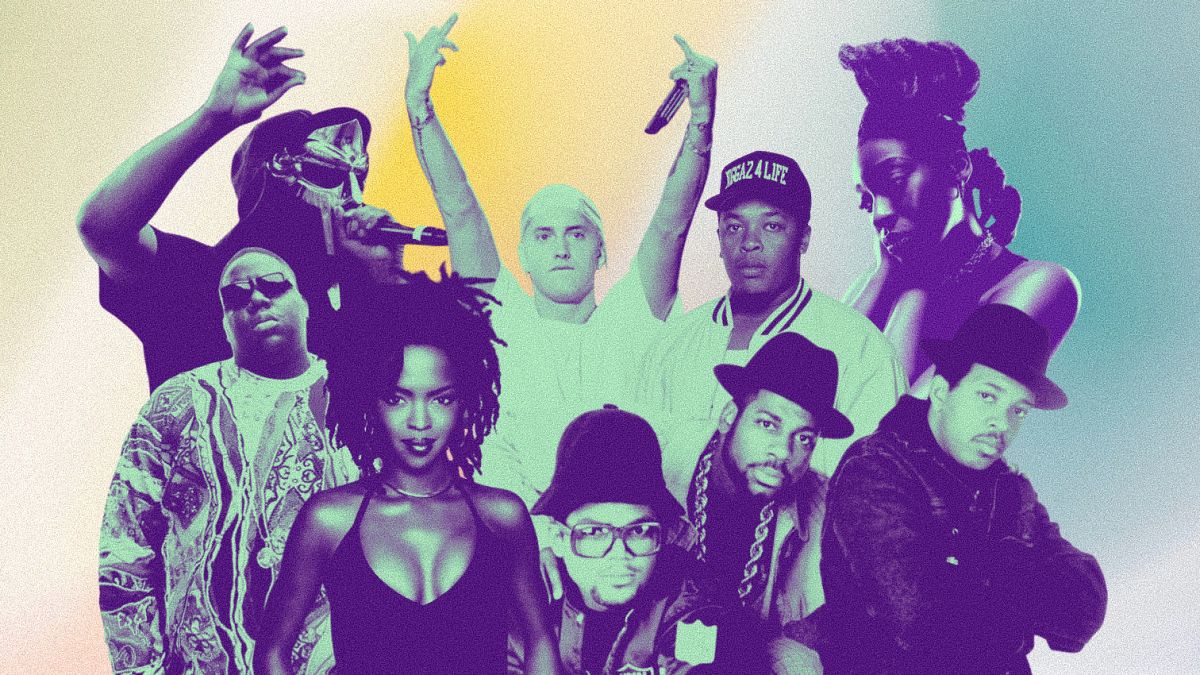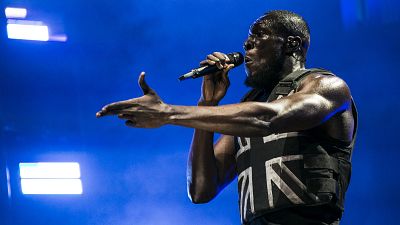Looking back at 50 years of hip-hop through the genre's most essential records.
In case you hadn’t heard, hip-hop celebrated its 50th anniversary this week.
It started as a niche movement in New York in the early 1970s, and now, it is the world’s biggest genre of music and permeates almost every aspect of modern music and pop culture.
The history of hip-hop as a culture can be overwhelming for novices; it is one of the richest and keeps on renovating itself. With this in mind, Euronews Culture has compiled a chronological list of the best hip-hop albums to listen to as an introduction to the genre.
While not exhaustive or encompassing the full scope of hip-hop music, these iconic records shaped the genre and remain influential to this day, across various other musical genres. The only rule we stuck to was that no artist or band must appear on this list twice, unless it is a solo project or a collaboration.
So, turn up your speakers – here are the essential records any self-respecting hip-hop fan should own.
The Sugarhill Gang – The Sugarhill Gang (1980)
The self-tilted debut from The Sugarhill Gang is widely considered to be the first hip-hop studio album. While not held in the highest of regards compared to most albums on this list, it remains an important landmark in the annals of hip-hop, especially for the track ‘Rapper’s Delight’ - which introduced the term ‘hip-hop’ into the wider lexicon. (It's worth noting that the term's origin story stems from Robert Keith Wiggins aka: Keef Cowboy, a member of group Grandmaster Flash & The Furious Five, who mocked one of his friends who had just joined the army and began chanting “hip hop” to mimic the cadence of marching soldiers.) While the scene had been thriving underground, the single offered a mainstream visibility unseen until then. The Sugarhill Gang weren’t lynchpins of the scene, but they tapped into the veins of the masses with an infectious and disco-inspired set of songs. They kicked off a popular appreciation for a genre that could well have gotten a different name had it not been for the Gang. David Mouriquand
Run-DMC**–**Run-DMC (1984)
Despite the genre being less than a decade old, Run-DMC's self-titled debut album in 1984 revolutionised the sound of hip-hop for an entire generation. The New York rap trio pioneered the much harder ‘New School' sound, characterised by heavy drum machines, paired with elements of rock and punk - effectively bringing an end to the funky ‘Sugarhill’ era of disco rap. The shift paved the way for other rap groups like N.W.A and Public Enemy, and played a pivotal role in propelling hip-hop further into the mainstream. Notably, the album became the first gold-selling hip-hop project, and the video for their standout track ‘Rock Box’ became the first rap video in history to air on MTV. While the sounds on this album definitely now feel a little dated, hip-hop owes a whole lot to Run-DMC. Theo Farrant
Public Enemy – It Takes a Nation of Millions to Hold Us Back (1988)
Public Enemy frontman Chuck D once described ‘It Takes a Nation of Millions to Hold Us Back’ as hip-hop's ‘Sgt. Pepper’s Lonely Heart Club Band’. Mr. D wasn’t far wrong with his comparison: Public Enemy’s sophomore record, like the Beatles’ celebrated album, was utterly groundbreaking, and stands as hip-hop's first bone fide masterpiece. Fuelled by righteous fury, it brings a punk sensibility to its themes of social injustice and Black empowerment. This record showed that the musical genre could serve as a political tool, in order to soundtrack the Black experience and carve out more space for people of colour in mainstream media. The scratches and samples mixed with some of Public Enemy’s strongest lyrics make this album the band’s best work; hits like ‘Don’t Believe The Hype’, ‘Bring The Noise’ and ‘Rebel Without A Pause’ served as an fiercer counterbalance to Run-DMC’s output, and their influence on hip-hop culture cannot be underestimated. So yes, ‘It Takes a Nation...’ is to hip-hop what ‘Sgt. Pepper’s...’ is to rock-pop, and it ushered in a new and influential era of socially engaged hip-hop. DM
N.W.A – Straight Outta Compton (1988)
The summer of 1988 saw the release of the unforgettable debut album from N.W.A. - ‘Straight Outta Compton’. The album depicts the life and struggles of living in a neglected and over policed area of LA County in the 1980s as Black people. The album’s most popular songs have since become international anthems against police brutality and the plight of Black people in the US: ‘Fuck tha Police’, ‘Gangsta Gangsta’ and ‘Straight Outta Compton’. Rhythmic record scratching and synth sounds guide you through the raw sometimes graphic storytelling present in the album. Ice Cube’s booming voice demands your attention as you start to get heated with him as he raps along. It wasn’t until the following year that the album got the attention it deserved when it peaked at number nine on Billboard’s Top R&B / Hip-Hop Albums. A performance of the song ‘Fuck tha Police’ was even disrupted by the police in Detroit in 1989. If you want to listen to an album to get you riled up about injustice, look no further than both Public Enemy and N.W.A’s 1988 output. Savin Mattozzi
Beastie Boys – Paul's Boutique (1989)
Following the commercial success of their debut album ‘Licensed to Ill’ (1986), the Beastie Boys had amassed quite the fanbase. Trouble is that the band weren’t too keen on the frat-boys and party bros. So, they moved from New York to LA, hooked up with the Dust Brothers, and executed a sonic left-turn that became a landmark album for hip-hop. It served as a veritable how-to on extensive and layered sampling and brought the practice to the forefront of the genre. Until sampling laws changed in the 90s. ‘Paul’s Boutique’ has aged like fine wine, and fizzles with hip-hop's core tenets: creativity and innovation. It did nothing short of capture one of the genre’s most exciting moments. Not bad for three white Jewish guys from NYC. DM
De La Soul – 3 Feet High And Rising (1989)
Like ‘Paul’s Boutique’, De La Soul’s debut album redefined the possibilities of sampling in hip-hop, and in the process redefined the genre itself. They layered, they juxtaposed, they introduced skits, and ended up with one of the most joyful hip-hop albums ever. The band represented a new direction, distancing themselves from the rage-filled output of their contemporaries and some of the nascent clichés in the genre. Instead of filing rank, they embraced a sense of witty but above all playful experimentation. ‘3 Feet High And Rising’ was the birth of alternative hip-hop, and its sonic collages and irresistible single ‘Me, Myself & I’ made quirky hip. DM
A Tribe Called Quest – The Low End Theory (1991)
It might feel redundant to describe an album with an adjective like “coolest”. However, this is most probably the coolest album of this entire list. For A Tribe Called Quest’s second album, Ali Shaheed Muhamma brought in samples from jazz and blues records as their peers looked to other genres. Combining a live recorded double bass with Q-Tip and Phife Dawg’s contemplative lyrics, ‘The Low End Theory’ feels like an album that has one foot in the works of Gil Scott-Heron’s early rap stylings, while another foot is firmly in the future of hip-hop. It’s an album so iconic, just featuring a verse could launch your career, as Busta Rhymes found with album closer ‘Scenario’. A must-own. Jonny Walfisz
**MC Solaar –**Qui Sème Le Vent Récolte Le Tempo (1991)
France remains the second-largest market for rap and hip-hop after the US to this day, and 'Qui Sème Le Vent Récolte Le Tempo' has a lot to do with it. The impact of this debut album from arguably the greatest hip-hop artist to come out of France really can’t be underestimated. With its tongue in cheek title, which comes from the French version of the Biblical proverb "qui sème le vent récolte la tempête" ("he who sows the wind reaps the whirlwind"), this record saw MC Solaar reap the rewards of his talent. Up-tempo and moody in equal measure, it delivered the hugely popular single ‘Bouge de là’, which kickstarted the icon’s career - still going strong more than 30 years later. Saskia O’Donoghue
Dr. Dre – The Chronic (1992)
If N.W.A had started and defined the gangsta rap era of hip-hop, Dr. Dre was the architect of its sound. Fresh out of his Ruthless contract, Dre formed Death Row Records with Suge Knight. Together, they’d go on to sign and produce the biggest talents of multiple generations, including 2Pac, Snoop Dogg, Eminem and 50 Cent. Arguably though, Death Row Records’ finest release was its first, Dre’s own solo album ‘The Chronic’. The album blends Dre’s eclectic musical tastes with live instrumentation forming the iconic G-Funk sound that defined 90s hip-hop. Dre's beats are some of his tightest, his bars are often among his best. Guest vocals from a then-unknown Snoop Dogg launched his career. This wasn’t just a great hip-hop album; it was a blueprint for the next decade of the genre. Only a generational artist like Dre could follow it up with the equally brilliant ‘2001’ in 1999. JW
Wu Tang Clan – Enter The Wu Tang (36 Chambers) (1993)
It’s hard to state just how unusual the Wu-Tang Clan seemed when they first arrived on the scene. A huge group of rappers, all with distinct personalities, rapping about topics as varied as racism, martial arts and chess. ‘Enter the Wu-Tang’ was the launch pad for all nine members, but it also changed the face of East Coast rap. While the NWA members were over in the West defining a new era of gangsta rap, Wu-Tang Clan brought a new rough-yet-polished production style to the scene. This is the quintessential New York rap album. Slick hooks, freeform verses, biting social commentary, and tongue-in-cheek wit. The whole thing feels almost improvised, yet dig deeper and levels of complexity in the group's lyrics betray the gargantuan intelligence of hip-hop’s most formidable group. JW
Guru– Jazzmatazz Volume 1 (1993)
“Peace, yo, and welcome to Jazzmatazz, an experimental fusion of hip-hop and live jazz,” announces the ever-so-suave Guru at the start of the Gang Starr MC’s 1993 solo album. At the time, hip-hop artists like A Tribe Called Quest and De La Soul were flipping jazz samples into their tracks. No surprise, as jazz has long been a part of hip-hop's roots, and for Guru, the next step was evident: reach out to original artists whose music they’d been sampling and book in some studio time. The result was Jazzmatazz, a celebration of a musical symbiosis that boasts the fusion East Coast hip-hop with live jazz artists and honours both genres brilliantly. Featuring the likes of N’Dea Davenport, Dee C Lee, MC Solaar, Courtney Pine, Ronny Jordan and Roy Ayers, it’s both a look to the past and to the future, with tantalizing tonal and tempo shifts that go from upbeat to chilled. While it may have been seen as an anachronism when it was released, this unique hip-hop album should feature in any collection worth its salt. DM
Nas – Illmatic (1994)
In 1994, a 20-year-old newcomer hailing from Queensbridge, New York, dropped an album that would go on to be considered one of the greatest and most influential hip-hop albums of all time. We’re talking about Nas’ 'Illmatic'. From his effortless flow to the depth of his lyrical prowess, Nas reshaped the entire genre with this album, setting a new benchmark for excellence. Enlisting the talents of some of hip-hop’s most legendary producers - Q-Tip, Pete Rock, DJ Premiere and Large Professor - Nas vividly captures the essence of life growing up in the projects of New York, against a backdrop of raw, boom bap beats. It’s ten sublime tracks, over 40 minutes, with no filler. An undisputed holy grail of hip-hop. TF
The Fugees – The Score (1996)
“It’s almost like a hip-hop version of Tommy, like what The Who did for rock music,” said Lauryn Hill of Fugees’ second (and final) album. A pretty accurate summation of what the Jersey trio composed of Hill, Wyclef Jean and Pras Michel achieved with the stunning ‘The Score’. At the time, hip-hop Was in excellent health but needed some broader appeal for those still sceptical about the genre. ‘The Score’ did just that, with some cross-genre appeal and radio-friendly tracks packed with all the sampling goodness the genre had become synonymous with. The single ‘Fu-Gee-La’ is based on Teena Marie’s ‘Ooo La La La’, ‘Ready Or Not’ is a cover of The Delfonics and samples Enya (ENYA!), and the huge hit ‘Killing Me Softly With His Song’ remains a terrific reimagining of the Roberta Flack tune. This was hip-hop by way of pop, distancing itself from the commercial success of gangsta rap without going too mainstream. And with 22 million albums sold worldwide, it became the best-selling hip-hop album by a group in history and assured the Fugees place in the genre's hall of fame. DM
IAM – L'Ecole Du Micro D’Argent (1997)
When Marseille-based French group IAM dropped ‘L’école du micro d’argent’ in 1997, they came to shape the country’s rap landscape for decades to come. A gritty, politically conscious record exposing the hardship of banlieue life, it connected the sounds of the US East Coast and French Mediterranean in a musically explosive mix. Indeed, the album's eponymous title track — a triumphant war cry asserting the supremacy of the “silver mic” school of rap — hits with the full force of the Samurai depicted on the album’s front cover. But beneath all the bellicose braggadocio, the record conceals a more introspective soul. We see it in tracks such as ‘Petit frère’ (‘Little brother’), which sympathises with the predicament of a young boy forced to grow up all too soon. IAM’s message clearly struck a chord with French listeners - ‘L’école...’ remains, to date, the country’s best-selling hip-hop album. Andrea Carlo
Notorious B.I.G. – Life After Death (1997)
Notorious B.I.G. aka Biggie was gunned down in his car on 9 March 1997 in a murder mystery that is still unsolved to this day. Just 16 days later, his double album aptly titled ‘Life After Death’ was released to an audience still mourning the death of the 24-year-old singer. During an era when hip-hop was still marred by violent rivalries, Biggie probably knew that he didn’t have that much time left to show the world his last stroke of musical genius, following his brilliant debut, 1994’s ‘Ready To Die’. The vast album covers everything from the harrowing account of a revenge murder in ‘Somebody’s Gotta Die’ to the impossible-to-not-bob-your-head-to ‘Hypnotize’. The album ends with the hauntingly prescient ‘You’re Nobody (Till Somebody Kills You)’. It’s one of those songs where you get so lost in the lyrics you forget that your body is still moving to the beat as the chorus flows in and out - “I don’t wanna die, God please tell me why.” SM
Lauryn Hill - The Miseducation of Lauryn Hill (1998)
In 1998, Lauryn Hill, already recognised as one-third of the rap group The Fugees, dropped her groundbreaking debut solo album titled, ‘The Miseducation of Lauryn Hill’. The release not only shattered records but also cemented itself as a cornerstone in the history of hip-hop. The album’s masterful fusion of R&B, reggae and traditional hip-hop, coupled with Hill’s socially conscious lyrics regarding life, love, Black empowerment and womanhood, struck a chord with listeners around the world. It won five Grammy’s including the coveted Album of the Year, becoming the first hip-hop album to ever do so, and helped inspire a new wave of female talent. Even now, as ‘Miseducation...’ approaches its 25th anniversary, it still retains its status as one of the exceedingly rare flawless albums. TF
Eminem – The Marshall Mathers LP (2000)
The third studio album by Eminem was hugely controversial at the time, but it has since been credited with popularising hip-hop in traditionally sheltered middle America. The tracks on this record, many a transgressive charting of his rise from rags to riches, his estrangement from his family and hitting out at critics, came to be a representation of popular angst of the American underclass. With songs including the seminal, endlessly catchy bop ‘The Real Slim Shady’ and the incredibly dark ‘Stan’ - still used to represent super fans who go a little too far - the collaboration between Eminem and Dr Dre has long been cited as an influence for many artists of various genres - and rightly so. SO'D
OutKast – Stankonia (2000)
OutKast’s genre-hopping classic ‘Stankonia’ provided the true blueprint for Southern rap. The seminal record of the Atlanta-based duo was released at the very start of the new millennium, and captured the zeitgeist of Y2K angst while simultaneously harkening back to the smoother memories of 1970s R&B. The album's lead single, ‘B.O.B (Bombs Over Baghdad)’, is a kaleidoscopic explosion of frantic drum and bass beats, funk guitars and gospel choruses that chronicles the ups and downs of ghetto life through war metaphors. But it was the subsequent release, ‘Ms. Jackson’ — an apology from André 3000 to Erykah Badu’s mother, for having a child with her daughter out of wedlock — that garnered the most success, shooting to the top of the Billboard Hot 100 and scooping up a Grammy. AC
Missy Elliott – Miss E... So Addictive (2001)
Get Ur Freak On! What would this list be without the long-time queen of hip hop? Missy Elliott’s third studio album firmly cemented her at the top of the genre, with fans and critics alike heaping praise onto the game-changing masterpiece. As well as the huge hit ‘One Minute Man’, ‘Get UR Freak On’ sounds as fresh today as it did 22 years ago. Alongside one of the most iconic music videos in hip-hop, the track brought in elements rarely explored by the genre. Featuring heavy bhangra elements straight out of Punjab, the MVP of female-led hip-hop proved her staying power. It’s no surprise that she became the first ever female hip-hop artist to be inducted into the Rock and Roll Hall of Fame earlier this year. SO'D
Madvillain – Madvillainy (2004)
Where to begin with the wonder that is 'Madvillainy'? Cult rapper MF DOOM and funk sample master and producer Madlib created the perfect alchemy, and their only album together was a bold creative step for underground hip-hop. It’s experimental, lyrically dense and nothing short of an ode to creativity. Tracks like ‘Accordion’, ‘Figaro’, ‘Fancy Clown’ and ‘All Caps’ are ones for the ages, and the album’s strength lies in its deliriously exciting blend of unconventional beats, top-notch MCing and spontaneous lyrical flow. This forward-thinking and eclectic album represented the future of hip-hop in 2004. It remains not only one of the genre’s greatest, but one of the best records of all time. DM
J Dilla – Donuts (2006)
Released a mere three days prior to his untimely death in 2006, ‘Donuts’ stands as the magnum opus of J Dilla, the beloved beatmaker and Soulquarian. This entirely instrumental album, which Dilla worked tirelessly to finish from his hospital bed, transcends the conventional bounds of hip-hop and crafts an extraordinary narrative without the need for an MC. Often referred to as “Jay Dee”, the Detroit producer pioneered a new sound within the genre, characterised by intricately sliced samples paired with raw, unquantized drums - all orchestrated through his iconic MPC 3000 drum machine. The style finds its pinnacle on ‘Donuts’, which serves as the legendary producer’s final goodbye to hip-hop. TF
Kayne West – Graduation (2007)
In a particularly timely example of separating the artist from the art, Kanye - or ‘Ye’ as he now chooses to be known - was at the top of his game with his third studio album. It rightfully went quintuple platinum and features on Rolling Stone's 500 Greatest Albums of All Time. Packed full of samples and synth sounds, ‘Graduation’ is credited with marking the end of the dominance of gangsta rap in mainstream hip-hop, instead paving the way for other artists who didn’t conform to gangsta conventions to find commercial success. Featuring collaborations with artists ranging from Elton John and Chris Martin to T-Pain and Lil Wayne, the tracks all stand the test of time, even if Kanye’s career and public image hasn’t quite managed that feat. SO'D
Kendrick Lamar – To Pimp A Butterfly (2015)
One of the reasons we’ve listed these albums chronologically is because hip-hop has followed a fascinating evolutionary trajectory since its nascence in 1973. When ‘To Pimp a Butterfly’ landed in 2015, it felt like a culmination of everything that had come before. Lamar’s status as a talented rapper was already assured from his sophomore album ‘good kid, m.A.A.d city’, but ‘TPAB’ put him in contention for greatest rapper of all time, respected by all the names listed above. If N.W.A’s ‘Fuck Tha Police’ soundtracked the 1992 LA riots, Lamar’s ‘Alright’ did the same for the Black Lives Matter protests. The concept album is a multi-dimensional diatribe against life in America. Lamar goes introspective on ‘u’, celebrates euphoric individuality on ‘i’, castigates his own racial politics on ‘The Blacker the Berry’, and delivers funky bops on ‘King Kunta’. Finally, he finishes on a dialogue between him and 2Pac on their roles as Black men with cultural influence. Lamar has had honours showered on him for all his albums, but his masterpiece is undoubtedly ‘TPAB’. Calling it a great hip-hop album is a disservice. Like ‘Madvillainy’, it’s one of the best albums ever written in any genre. JW
Run The Jewels – RTJ4 (2020)
With four straight near-perfect albums under their belts, it can be difficult to pick a standout from El-P and Killer Mike – aka: Run The Jewels. They’ve established themselves as one of the best modern hip-hop acts around, embracing the genre’s socially-conscious persuasion with a sense of sincere, righteous anger that never topples into mindless aggression or easy hectoring. While ‘RTJ2’ is widely considered to be their strongest, their most recent album, ‘RTJ4’, is their most ambitious and perfectly produced. Dropping at the height of the Black Lives Matter protests in June 2020, the album’s politically charged themes regarding systemic racism in the US are timely, thoughtful and coupled musically exhilarating tracks - with A-list appearances from the likes of Pharrell Williams, Zach de la Rocha and Mavis Staples elevating RTJ4’s raw energy. The greatest duo in hip-hop history? You better believe it. DM
Little Simz – Sometimes I Might Be Introvert (2021)
‘Sometimes I Might Be Introvert’ (SIMBI) is the fourth studio album released by the phenomenal 29-year-old London-born rapper, Little Simz. While firmly rooted in hip-hop, this project weaves together an array of other influences, spanning from funk to soul, jazz to afrobeat. From the orchestrally epic opening track ‘Introvert’, to the Smokey Robinson soul sampling bliss of ‘Two Worlds Apart’, the diverse instrumentals act as the perfect backing for Simz’s commanding voice and razor-sharp lyrics, which touch on themes of systemic racism and womanhood. In a time where the question of hip-hop's vitality often arises, Little Simz stands as a living testament that the genre is unequivocally alive and thriving. TF
Happy listening!
NB: This article was originally published on 10/08/23



